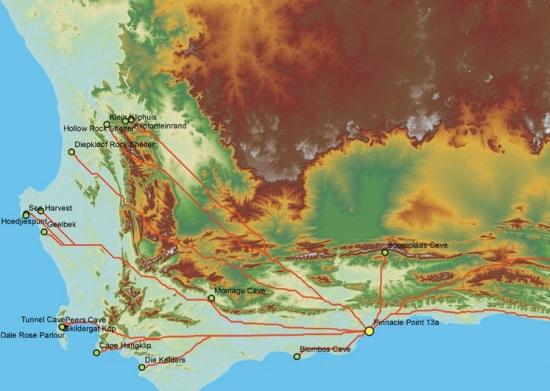Source - http://popular-archaeology.com/issue/june-2013/article/middle-stone-age-picnics-on-the-beach
It may not be an implausible leap to imagine a small band of hunter-gatherers composed of extended family and friends having a seasonal picnic on the beach about 100,000 years ago on what is today’s western South African Atlantic coast. It is a picture that could be painted with the help of results from a recent research study conducted by archaeologist Katharine Kyriacou of the University of Cape Town, South Africa, and colleagues from the University of Tübingen and the Heidelberg Academy of Sciences and Humanities.
Following renewed excavations in 2011 under the University of Tûbingen’s N. J. Conard at the open-air coastal site of ‘Hoedjispunt 1’ (HDP1) located on a peninsula jutting out into the Saldanha Bay of South Africa’s southwestern Cape, Kyriacou and her colleagues performed extensive analysis and additional dating on assemblages of lithic artifacts and associated shellfish remains systematically collected from that site and other related sites in the region, such as the nearby sites of Lynch Point and Sea Harvest. These are sites that have yielded evidence of human occupation during the Middle Stone Age (MSA, or 280,000 – 50,000 BP), a time range within which anatomically modern humans (AMH), or early modern humans, were present on the African landscape. Their results showed clear collection and consumption/preparation of selected types of high meat-yielding shellfish using stone artifacts, some made locally and others transported from distant locales, within a pattern of short-term periodic encampments or stays. The HDP1site has been tentatively dated, based on past uranium series, infrared stimulated luminescence, and electron spin resonance dating, including new dating that is yet to be completed, to as early as 115 – 130 ka.
“Based on these age determinations, HDP1 is the oldest known shell-bearing site along the Atlantic west coast,” write Kyriacou, et al.*

The Hoedjiespunt site, far left, in relation to other MSA sites across southwest South Africa. From the Role of Culture in the Early Expansion of Humans (ROCEEH). Map shows 'least cost path' analysis of connectivity between MSA sites and Pinnacle Point, one of the oldest MSA sites. Wikimedia Commons
Kyriacou and colleagues reinforce an emerging view among scholars on the nature of early modern human habitation and movement in the coastal areas and their diets, which has significant implications for human evolution during this time period.
“Small groups of foragers engaged in the selective exploitation of a narrow range of mussels and limpets, particularly large species from the mid-intertidal, during relatively short excursions to the coast,” concluded the authors. “The integration of simple marine resources into the diets of people visiting the Atlantic west coast probably had major implications for the evolution of modern humans in this region. Shellfish represent an easily accessible and reliable source of nutrition on a landscape characterized by seasonal fluctuations in the availability of terrestrial resources [other prey further inland]. The consumption of even small quantities of mussels and limpets would have helped prehistoric people meet their requirements for essential nutrients, especially trace elements and polyunsaturated fatty acids [critical for brain development].”*
The research report is published in the Journal of Archaeological Science.
*K. Kyriacou, et al., Middle and Later Stone Age shellfish exploitation strategies and coastal foraging at Hoedjiespunt and Lynch Point, Saldanha Bay, South Africa, Journal of Archaeological Science 57 (2015) 197 – 206.